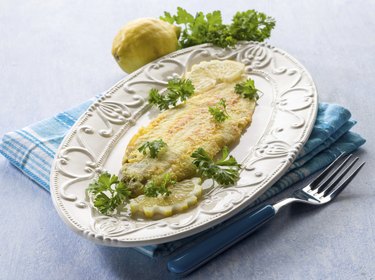
The 2015-2020 Dietary Guidelines recommend humans over 2 years old consume at least 8 ounces of seafood weekly. Even pregnant or nursing women can safely consume more by choosing low-mercury fish such as Dover sole. Bake it for a low-fat, rich taste.
Read more: How to Cook Fish Without Oil
Video of the Day
Video of the Day
Understand Sole Nutrition
Baked sole offers optimal nutrition from this mild, sweet and meaty fish. Sole contains some of the lowest levels of mercury of any fish, according to the Environmental Protection Agency (EPA), with just 0.06 micrograms per gram. The fish is included on the EPA's "Best Choices" list for fish, with three 6-ounce servings weekly of roast Dover sole being perfectly safe for adults, according to Harvard Health Publishing.
A 4-ounce fillet of roast Dover sole contains 102 calories and less than a gram of fat, according to the USDA, making it a wise choice for those watching their dietary lipids.
Roast Dover sole is a mainstay of European cuisine with a reputation as the "Rolls Royce of Fish" according to butcher Donald Russell, holder of a Royal Appointment to the Households of Her Majesty the Queen for 40 years. Although Dover sole gained its notoriety from the town of Dover in England, most of the Dover sole sold in the U.S. swims along the west coast of North America, from the Bering Sea to the Baja Peninsula, according to the National Oceanic and Atmospheric Administration (NOAA). NOAA sustainably manages the Dover sole population through the limiting of permits, season and fish size, and other restrictions.
When buying Dover sole fillets at the store, make sure the flesh is firm, and that it feels cold, slippery and wet, not sticky. A whole fish should have clear eyes, intact fins, and red gills, according to UC Davis Health. You can also buy fillets or entire fish frozen. Thaw them in the refrigerator overnight, and use them within 24 hours, advises Donald Russell.
When you're ready to make baked sole, pass the fish quickly beneath running water — don't let them soak or they will get a squishy texture— and pat them dry with a paper towel. Make two knife incisions in the thickest part of each filet — or the top fillet if cooking an entire fish — to ensure even cooking.
Cooking Filet of Sole
Preheat your oven to 400 degrees Fahrenheit, according to UC Davis Health. Approximate 10 minutes in the oven for each inch of thickness, or until an internal thermometer reaches 145 F.
You can spice up the fish's mild taste with herbs such as parsley, spices like pepper, paprika or garlic, or coat it in olive oil or lemon juice. Donald Russell recommends basting it with butter halfway through its cooking time.
Read more: The Top 10 Healthy Fish to Eat
You could also take a page from the Mayo Clinic's recipes, and make a heart-healthy, spinach-stuffed sole. Sautée 2 cups of chopped spinach leaves and 2 teaspoons of garlic in a teaspoon of olive oil. Add a few twists of black pepper, to taste, and cook until the spinach begins to wilt, approximately 3 minutes.
Place the Dover sole fillets in a spray-coated baking pan, and divide the spinach mixture onto them. Roll the fillets up with the spinach mix inside, and the seam side against the bottom of the pan. Brush each fillet with ¼ teaspoon of melted butter, and bake at 400 F, for 8 to 10 minutes.
You'll know when the fish is done when a knife can easily pierce the flesh, making it flake apart. Enjoy your heart-healthy meal.
- U.S. Food and Drug Administration: "Advice About Eating Fish"
- Donald Russell: "Dover Sole"
- The Royal Warrant Holders Association: "Donald Russell"
- Environmental Protection Agency: "EPA-FDA Fish Advice, Technical Information"
- Harvard Health Publishing: "Make Smart Seafood Choices to Minimize Mercury Intake"
- U.S. Department of Agriculture Food Data Central: "Fresh Wild Dover Sole Fillets"
- NOAA Fishwatch: "Dover Sole"
- UC Davis Health: "Guide to Healthy Seafood and Why You Should Eat More"
- Office of Disease Prevention and Health Promotion: 2015-2020 Dietary Guidelines
- Mayo Clinic: Spinach Stuffed Sole